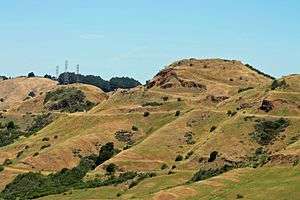Moraga Formation
| Moraga Formation (Moraga Volcanics) Stratigraphic range: Pliocene epoch | |
|---|---|
 Moraga Volcanics in Robert Sibley Volcanic Regional Preserve, Berkeley Hills | |
| Type | Geologic formation |
| Underlies |
Siesta Formation of Great Valley Group |
| Overlies | Orinda Formation |
| Thickness | 1,200 feet (370 m) |
| Lithology | |
| Primary |
Basaltic lava, with andesite, basalt, rhyolite tuff |
| Other | Clay, conglomerate, limestone |
| Location | |
| Region |
Berkeley Hills, Alameda County and Contra Costa County, California |
| Country | United States |
| Type section | |
| Named for | Moraga Valley |
The Moraga Formation or Moraga Volcanics is a Pliocene epoch volcanic geologic formation in the Berkeley Hills of the East Bay region of the San Francisco Bay Area, California. [1]
The basaltic lava flow formation is found within Alameda County and Contra Costa County. [2][1] It can be seen in the Robert Sibley Volcanic Regional Preserve and Caldecott Tunnel area of the Berkeley Hills. [3] It is named for an exposed occurrence in the Moraga Valley.
It overlies the Orinda Formation, and underlies the Siesta Formation of Great Valley Group. [4]
- Fossils
It preserves freshwater fossils dating back to the Pliocene epoch of the Neogene period. [5]
See also
- Mulholland Formation — occurs to the south, in the Berkeley and San Leandro Hills.
- Pliocene California geology
- List of fossiliferous stratigraphic units in California
- Paleontology in California
References
- 1 2 USGS.gov: "Upper Cretaceous and Lower Tertiary Rocks Berkeley and San Leandro Hills, California", by J. E. Case, GEOLOGICAL SURVEY BULLETIN 1251-J, 1968.
- ↑ Oakland Geology Blog: "Grizzly Peak and Moraga basalt"
- ↑ Geology.about.com: "California Transect - Stop 30, Orinda Formation and Moraga Volcanics"
- ↑ Lawrence Berkeley Lab.gov: "Berkeley Lab Geologist Studies the Ground Beneath His Feet"
- ↑ Various Contributors to the Paleobiology Database. "Fossilworks: Gateway to the Paleobiology Database". Archived from the original on 31 July 2014. Retrieved 8 July 2014.
External links
- East Bay Regional Parks.org: official Robert Sibley Volcanic Regional Preserve website
- EBparks.org: Volcanism at Sibley Volcanic Preserve
| Wikimedia Commons has media related to Robert Sibley Volcanic Regional Preserve. |
This article is issued from
Wikipedia.
The text is licensed under Creative Commons - Attribution - Sharealike.
Additional terms may apply for the media files.